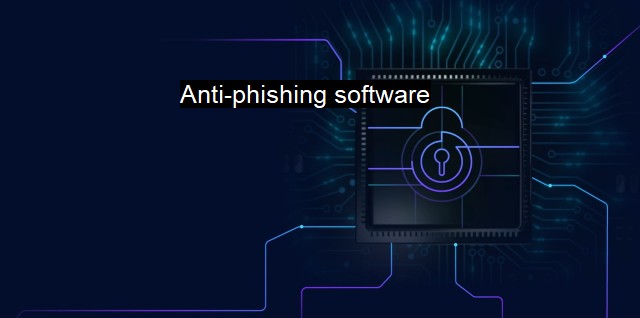What is Anti-phishing software?
Exploring the Power of Anti-Phishing Software in Combating Cyber Threats: Preventing Phishing Attacks in Real-Time Using Advanced Machine Learning Algorithms
Anti-phishing software is an essential tool in today's digital world to safeguard one's personal and financial information from threats. It operates as a cybersecurity defense, often as an integral part of an antivirus package, offering a protective shield against deceptive cyber practices. The function and importance of anti-phishing software increase with the ever-evolving panorama of cybersecurity threats.Phishing, to get a grasp of the significance of anti-phishing software, is a notorious online scheme where individuals are deceived into giving out personal or financial information. Cybercriminals often achieve this by impersonating established financial institutions or companies via electronic communications like emails. Victims are directed to websites that appear genuine and are coaxed to disclose information. These data can then be used for various fraudulent activities like identity theft and financial fraud.
Against this backdrop, the role that anti-phishing software plays becomes clear - it identifies and blocks phishing attempts. Whenever a user clicks on a suspicious link in an email or attempts to visit a fake site, the software warns them about the potential threat. This early alert allows the user to halt the action and evade falling into the deception.
Most anti-phishing software is developed around algorithms that identify phishing tactics. These algorithms review and scrutinize the webpage’s URL, domain name, and IP address. If a site does not match established databases of well-known phishing sites and shows irregularities in its content structure characteristic of phishing sites, the software raises an alarm.
Anti-phishing software also plays a vigilant role in spotting malicious scripts or codes embedded into web pages that might load onto a user's system and cause harm. This can comprise damaging malware that captures keystrokes, exploring the system for potential weaknesses, or even taking control of the computer.
In some cases, anti-phishing software has functionalities beyond active threat response. It tends to keep snapshot records of user activity with the intent of tracing back activities that could potentially have led to a phishing attack. This sort of evidence can even enable cybercrime investigations, providing substantial insights into the culprits' identity and mode of operation.
Often, anti-phishing software extends its protective cover beyond computers to mobile phones. Given today's increasing dependency on mobile devices for various transactions, the risk posed by phishing attacks has extended to smartphones too. Mobile phishing or smishing is growing, motivating the expansion of anti-phishing software features to actively shield mobile devices similar to PCs.
While anti-phishing software offers significant protection, its existence does not entirely eliminate the threat. Sophisticated cybercriminals devise innovative scam techniques, outrunning existing capabilities of the software. The software must continuously update its knowledge, change its strategies, and improve its algorithms to stay ahead in this ongoing war with hackers.
Therefore, the importance of remaining vigilant cannot be overstated. Aside from relying on anti-phishing software, individuals should also make conscious decisions – refraining from clicking on dubious links, verifying sender credentials, checking for encryption before divulging personal or financial details, etc. The role of anti-phishing software is not to replace these safe browsing practices but to supplement them.
Anti-phishing software is a vital part of any multi-layered cybersecurity strategy. It transforms from a sword, aggressively flagging potential phishing attacks, to a shield, defending the system from loaded malicious codes and securing the personal or financial information of users. It’s an indispensable tool in our pursuit to stay safe in a digital world permeated by cybersecurity threats. concurrent emphasis on user education about secure browsing habits ensures optimal effectiveness of anti-phishing software. After all, an awake user is the best defense against phishing crimes.

Anti-phishing software FAQs
What is anti-phishing software?
Anti-phishing software is a type of cybersecurity tool that is designed to protect users from phishing attempts. It works by analyzing and identifying suspicious websites, emails, and messages that may be attempting to steal sensitive information.How does anti-phishing software work?
Anti-phishing software typically uses a combination of techniques, such as heuristics, blacklists, and whitelists, to identify phishing attempts. Heuristics involve analyzing the content and behavior of emails and messages to identify suspicious patterns. Blacklists contain known phishing websites and domains, while whitelists contain trusted websites and domains.What are the benefits of using anti-phishing software?
The main benefit of using anti-phishing software is that it can help protect users from falling victim to phishing attacks. By identifying and blocking suspicious websites and messages, anti-phishing software can prevent users from entering their personal and financial information on fraudulent websites. This can help prevent identity theft, financial fraud, and other cybersecurity threats.Do I need to use anti-phishing software if I have antivirus software?
While antivirus software can provide some protection against phishing attempts, it may not be enough to protect users from all types of attacks. Anti-phishing software is specifically designed to detect and block phishing attempts, which may not be detected by antivirus software. Therefore, it can be beneficial to use both antivirus and anti-phishing software to ensure comprehensive protection against cybersecurity threats.| | A | | | B | | | C | | | D | | | E | | | F | | | G | | | H | | | I | | | J | | | K | | | L | | | M | |
| | N | | | O | | | P | | | Q | | | R | | | S | | | T | | | U | | | V | | | W | | | X | | | Y | | | Z | |
| | 1 | | | 2 | | | 3 | | | 4 | | | 7 | | | 8 | | |||||||